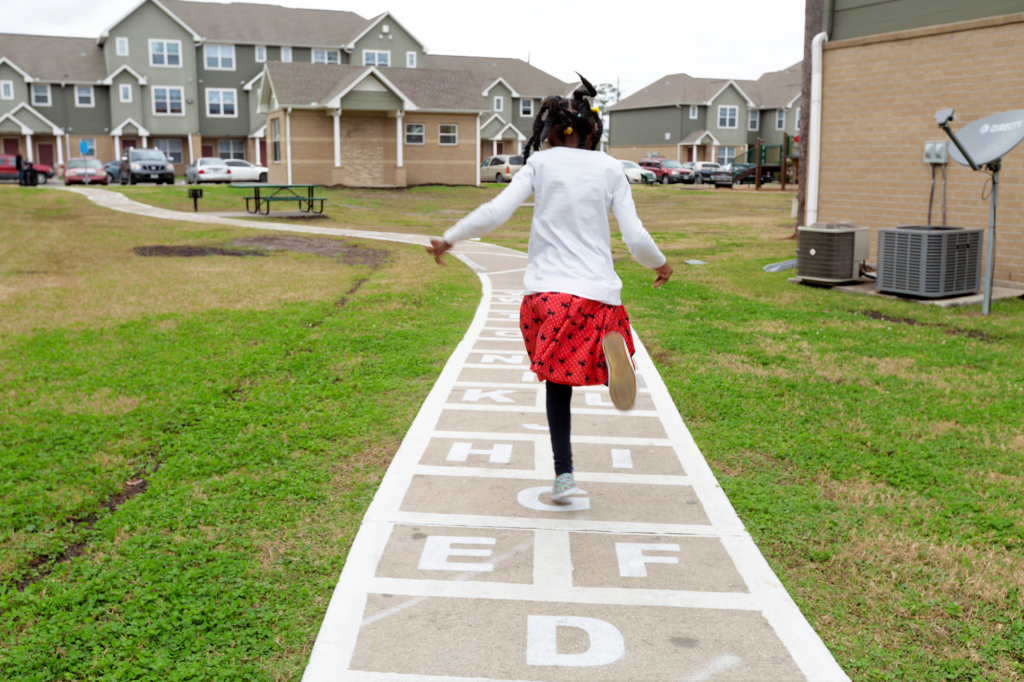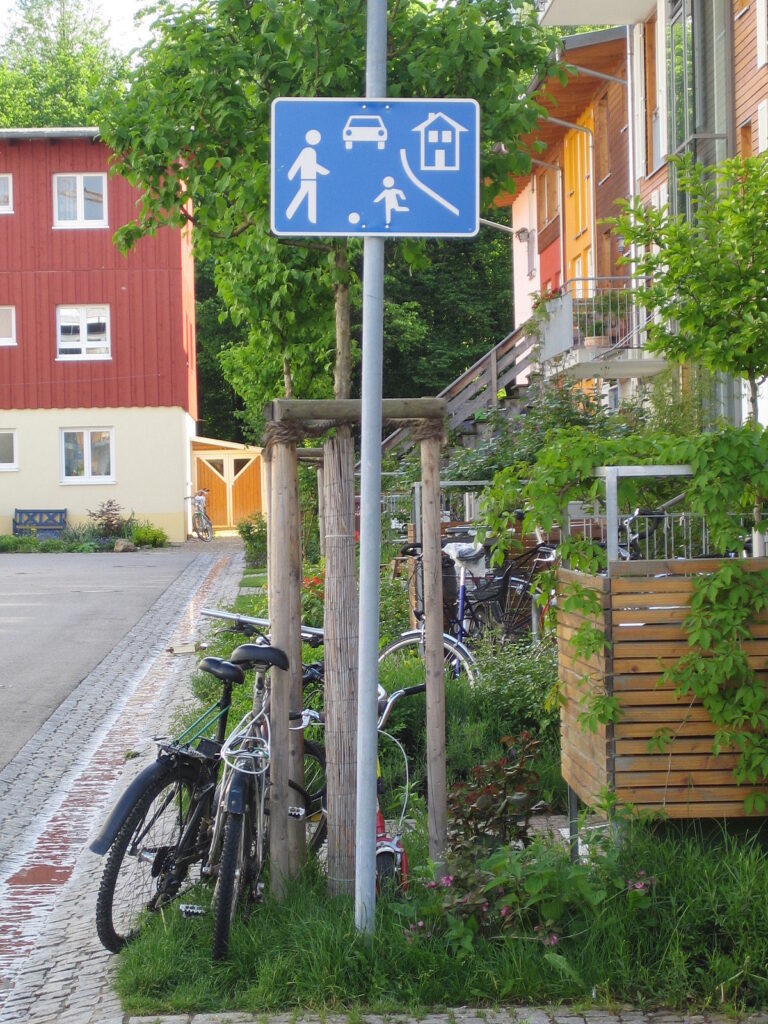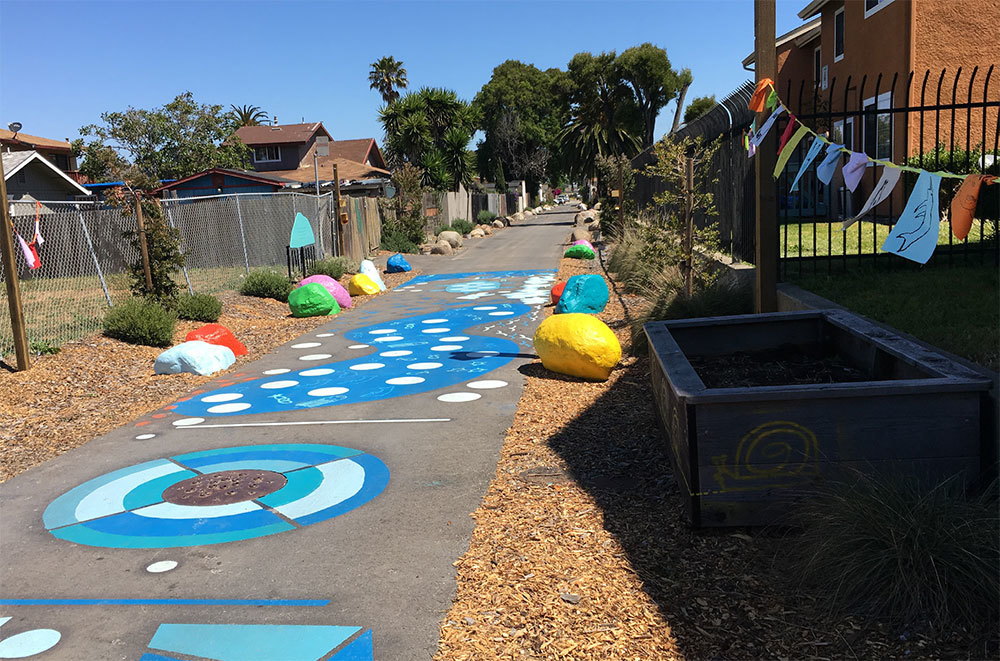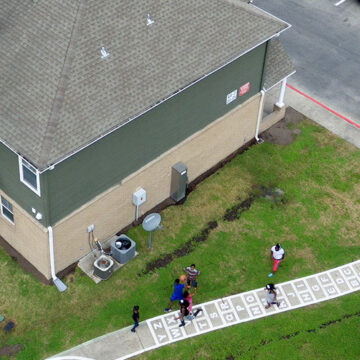With some creative thinking, play can be located close to home. Not just nearby— in fact, right where kids live. Residential communities, including multi-family complexes that many kids call home, offer untapped opportunities for convenient play. It is easy to find a common area, open space, pathways, an underutilized parking area or other leftover spaces that could be put to better, and more playful, use. With kids already playing in these spaces, there are opportunities to learn from, and build upon, existing patterns of play.

The designs of many multi-family housing communities may not foster human interaction of any sort, let alone inspiring play and providing welcoming environments for kids and families. Fragmented or dispersed housing layouts, combined with the lack of suitable places to gather, can have the effect of keeping neighbors away from each other, rather than bringing them together. Fences may separate residents, while discouraging access to usable open spaces. And yet, there is no better way to unlock and transcend these physical and psychological barriers in a residential community— and to foster connections among residents—than by giving kids places to play just outside their door.
Design Principles
Given the ample opportunities for play within existing multi-family housing communities, these design principles focus on retrofitting existing housing developments for play. Many of the same ideas and principles can be integrated into the design of new housing, which can be an attractive feature for prospective residents.
Open spaces and courtyards
Many housing complexes and residential communities are designed to include open spaces, such as open lawns and grassy areas or courtyards framed by residential buildings. In some cases, these spaces may be designed as formal gathering spaces and outdoor amenities for residents. In other cases, they may be underutilized, or serve no discernible purpose other than to provide some greenery, buffer adjacent residences or the street or fill unused space. Such spaces can be ready-made opportunities for play, by:
- Locating a play installation in open spaces, such as lawn areas or the open buffers and borders along the edges of a residential property. While any available space will do, selecting central and visible locations at the centers or fronts of housing complexes will not only attract more kids, but can also enable more adult “eyes” on the playspace.
- Retrofitting existing courtyards, or other outdoor common spaces that accommodate play.
- Repurposing the fences and gates that surround many common and open spaces to include playful features; for example, if the fences are in the “wrong place” from a kids’ perspective, and discourage—rather than welcome—play, consider taking them down entirely.
- Celebrating big, mature trees that offer multiple opportunities for play. This can include offering secluded enclosures, addresses for treehouses or surfaces on which to post playful names and games. Even the trunks or stumps of fallen trees can find new life as play structures.
- Utilizing gardens and other natural areas for play by simply planting colorful flowers and other interesting plants. By inviting kids to explore them, these spaces can inspire play and stir the imagination.
- Taking advantage of the city streets, sidewalks, pathways and entrances of residential communities that offer myriad opportunities for creative play. In a residential context, the opportunities include painting murals, games or other play opportunities on the sidewalks and pathways within a residential community. These connectors can establish a “mini play trail” that links play installations from one part of a residential development to another.
- Transforming outdoor staircases—where changes in topography exist—into playful experiences, which makes the climb, or descent, less onerous.

Parking and alleys
While it is not advisable to mix kids with cars, residential developments may have underutilized vehicular spaces, such as parking lots, driveways or alleys that can be closed off to cars, or at least prioritized, for play. Cities can use these spaces by:
- Repurposing portions of underutilized parking lots, or even a few parking spaces, as zones for play. If a parking lot has more parking spaces than it needs, consider consolidating parking and devoting a portion of it (with appropriate demarcation and safety barriers) to something playful, such as murals, games or a play structure.
- Creating a play alley within a residential development. Close off alleys or driveways to vehicular traffic. If the alleys or driveways are still needed for service or loading access, consider limiting vehicles at certain times. In some locations, there may be the opportunity to create a “shared street” or woonerf environment in which design features and environmental cues making it clear that playing kids and pedestrians are the priority (see also Streets and Sidewalks).

Other options
Some residential developments may lack the types of spaces described above, or other factors may impede the creation of play installation. In such cases, other options might exist, such as:
- Partnering with the owners and property managers of nearby housing complexes to establish a “play district” which oversees the creation, maintenance and operation of shared playspaces serving the residents of more than one housing complex. If businesses can form business improvement districts, which help fund the maintenance and improvement of commercial areas, why couldn’t residential communities team up to create, fund and maintain playspaces within a larger residential area?
- Putting play installations on rooftops. In denser urban environments, outdoor spaces around housing may be limited, but many apartment buildings have accessible rooftops as resident amenities. With proper safety precautions and enclosures, rooftops can become places for play, that are extremely close to home, yet in a seemingly secret, and special, world above the city.
- Repurposing indoor common spaces as play areas. While fresh air is good for young bodies and minds, when all else fails, or during cold or inclement weather months, indoor playspaces can allow kids to burn energy and ignite their imaginations without having to go outside.
- Locating play installations close to laundry rooms and other communal facilities, to allow kids to play while their parents and caregivers tend to other tasks.
General considerations
- Observe where and how play is already occurring in a residential development. Collaborate with the kids who live and play there to design for their needs, build upon and formalize existing play routines and inspire a sense of ownership.
- Maximize play opportunities in centrally-located and visible spaces, or close to major pedestrian routes, so that spaces are accessible to the maximum number of kids, while enabling more adult “eyes” to monitor or supervise the play installation. Since the sound of laughter can be a magnet for other kids, try locating playspaces where the joy will be audible. Additionally, locating play in prominent locations and at the front of redevelopments can make a powerful statement that kids not only live there, but are welcome to play there.
- Respect residents’ privacy. To the extent possible, avoid locating playspaces too close to individual residences; if privacy or noise concerns become an issue, consider incorporating landscaping or other screening as a buffer between homes and playspaces.
- Work with housing authorities, property managers and resident associations to build support and consensus. Some residential communities may have restrictions on where play is allowed to occur, particularly in spaces adjacent to residences, or around building infrastructure and service areas. However, play should be allowed to occur in common areas. If faced with resistance to a play installation, note that federal and state fair housing laws protect the rights of kids to use and enjoy a residential property. Housing providers are generally prohibited from imposing rules that single out kids, except when the rules are intended to ensure the health, safety and welfare of others.
- Provide amenities, activities and comfortable spaces that invite residents of all ages and abilities to take part in the play experience. Residential playspaces offer opportunities to bring together—and foster connections between—all residents, while building the sense of trust and shared experience that are the foundations of successful residential communities.
- Consider including a sequence and variety of playspaces throughout a residential development to not only bring play closer to more kids, but to also provide enough variety to keep kids of all ages interested and engaged.
